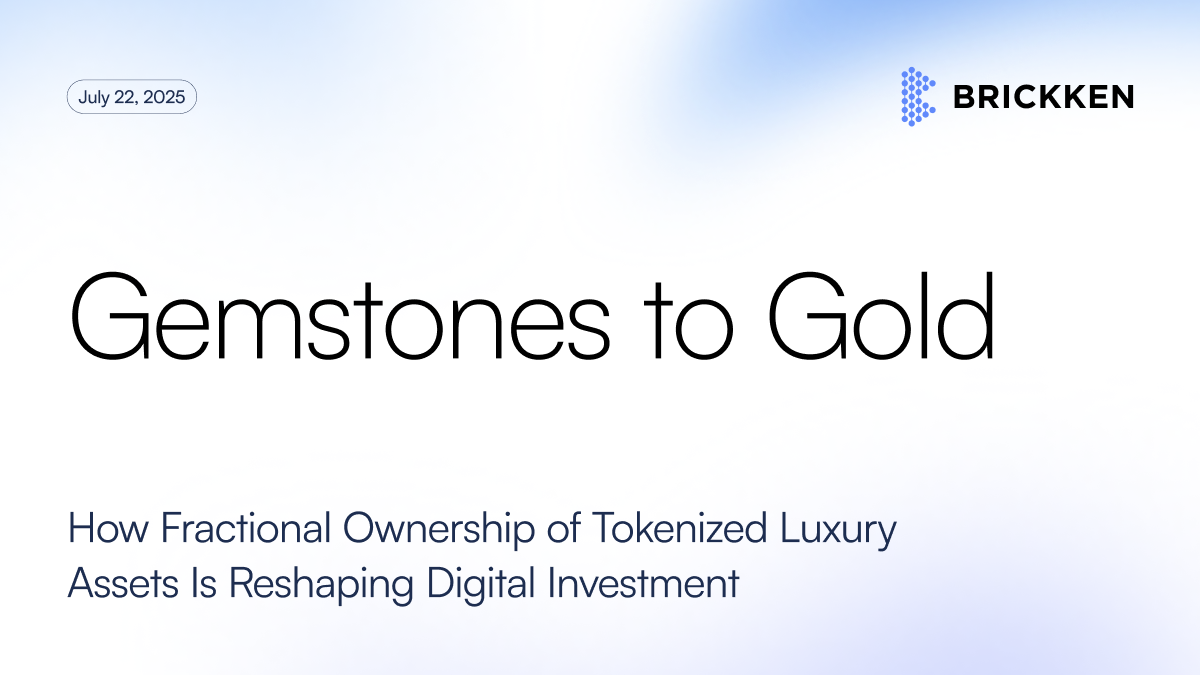Summary
Looking to invest in rare and valuable items? Tokenization opens that door.
- What you can tokenize: Assets such as rubies, diamonds, gold bars, and luxury watches are just the beginning. Through tokenization, nearly any valuable real-world asset can be transformed into a digital asset on blockchain. Examples include gemstones, fine art, antiques, collectibles, and many others.
- Why it matters: Tokenization removes traditional barriers. It makes elite investments more accessible, improves liquidity, and helps prevent fraud.
- How it works: Each asset is authenticated, securely vaulted, and digitally represented using smart contracts. Investors can purchase fractional shares through blockchain-based tokens.
- Examples in action: Projects like Pax Gold, Tiamonds, and Expobank’s tokenized diamonds show how this is already happening.
- Key benefits: Open access, traceable ownership history, data transparency, and faster peer-to-peer transactions.
- What to consider: Legal treatment of asset-backed tokens, custody solutions, smart contract reliability, and physical redemption logistics.
Unlocking Value in Illiquid Luxury Markets
Gemstones and precious metals have always served as long-term stores of value. Yet for most investors, they remain out of reach. Here’s why:
Traditional barriers to luxury asset investing
- High entry cost. A premium ruby or gold bar can cost tens of thousands of dollars.
- Illiquidity. Selling physical assets typically involves intermediaries and long timelines.
- Opaque markets. Pricing and authentication are not always transparent.
- Fraud exposure. Counterfeit jewelry and synthetic stones are common.
- Limited global access. Physical custody and jurisdiction create access limitations.
Tokenization: Turning Luxury Into Digital Assets
Tokenization refers to converting a physical item into a tradable digital asset on the blockchain. Each token represents fractional ownership in the real-world asset it corresponds to.
This benefits investors by allowing them to:
- Invest in luxury markets at lower price points
- Trade high-value assets with near-instant settlement
- Verify authenticity and provenance using blockchain metadata
It also empowers asset holders to:
- Unlock capital without fully liquidating their assets
- Reach a wider, digitally native investor audience
- Deter fraud by linking tokens to verifiable, on-chain data
Step-by-Step: From Vault to Token
Here’s a breakdown of how a luxury item becomes a digital asset:
- Evaluation. Certified experts assess the item’s quality. For gemstones, this often involves grading by institutions like the Gemological Institute of America (GIA), which evaluates based on the 4Cs: cut, color, clarity, and carat weight.
- Certification. An official record verifies the asset’s authenticity and specifications.
- Vaulting. The asset is securely stored in an insured, compliant custody facility.
- Token creation. A smart contract is used to mint blockchain tokens that represent shares of the physical asset.
- Distribution. Investors purchase and trade these tokens via a digital platform. Ownership is recorded and updated in real time.
This process delivers transparency, trust, and efficiency to markets that have long relied on opaque intermediaries.
Spotlight: Gemstone Tokenization in Practice
Examples of tokenized gemstones highlight how technology is transforming access and security:
Tiamonds on Cardano
- Diamonds graded by the GIA are tokenized and stored in high-security Swiss vaults.
- Investors can choose to trade tokens or redeem them for the underlying physical stones.
Expobank’s 3-Carat Diamond
- The diamond was divided into 5,000 blockchain tokens.
- Fractional ownership allowed wider access to an otherwise exclusive asset.
These use cases bring verifiability, liquidity, and global access to previously restricted asset classes.
Gold and Precious Metals: The Leading Edge
Among luxury assets, gold has taken a clear lead in tokenization. Here's how:
Pax Gold (PAXG)
- Each token represents one troy ounce of gold.
- Fully backed by reserves stored in LBMA-accredited vaults.
- Easily tradable on crypto exchanges.
Tether Gold (XAUT)
- Backed by physical gold held in Swiss vaults.
- Offers low entry costs through fractional ownership.
- Market capitalization exceeds $800 million.
Other metals such as silver, platinum, and palladium are also entering the tokenization space. These tokenized assets provide diversified exposure to tangible commodities, often with lower barriers to entry.
Jewelry and Diamonds: Digital Trust for Physical Value
Luxury jewelry is being transformed by tokenization in ways that solve long-standing challenges for both investors and brands.
For investors:
- Trace the origin, ownership, and authenticity of pieces
- Ensure ethical sourcing and fair-trade practices
- Trade or redeem digital shares securely and transparently
For asset holders and luxury brands:
- Create tamper-proof records of ownership and design
- Protect intellectual property through digital documentation
- Open resale channels through digital marketplaces
This digital transformation builds long-term trust and creates new monetization paths for creators and collectors alike.
Key Considerations Before Investing
Tokenization of high-value assets brings innovation but also risk. Key factors to consider include:
- Regulatory classification. Rules differ across countries regarding tokenized securities and commodities.
- Custodial infrastructure. Secure and insured vaults are non-negotiable.
- Smart contract quality. Poor coding can introduce irreversible errors or vulnerabilities.
- Redemption process. Shipping physical items introduces logistical and cost challenges.
Platforms that provide built-in compliance, secure vaulting, and well-audited smart contracts, such as Brickken, are reducing these risks significantly.
Looking Ahead: The Digital Evolution of Luxury Investment
Tokenization is transforming the luxury asset market. It brings efficiency, access, and security to a domain historically known for exclusivity and opacity.
With tokenization, luxury becomes:
- More accessible to investors through fractional ownership
- Easier to trade thanks to global digital marketplaces
- Safer to invest in due to verified records and transparent transactions
Platforms like Brickken equip businesses with modular tools to tokenize, manage, and distribute real-world assets at scale. This includes:
- Smart contract infrastructure
- Compliance modules
- Onboarding workflows
- Payment integration (crypto and fiat)
- Governance and investor management tools
By using Brickken’s infrastructure, asset managers, institutions, and luxury brands can enter the digital asset economy without the need to build from scratch.
The future of luxury investment isn’t just physical. It’s digital, programmable, and decentralized.
Interested in learning more about gemstones tokenization? Book consultation with our specialists.
